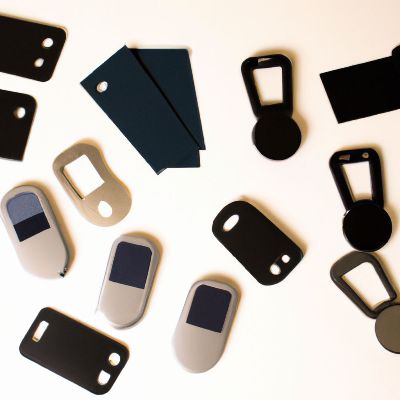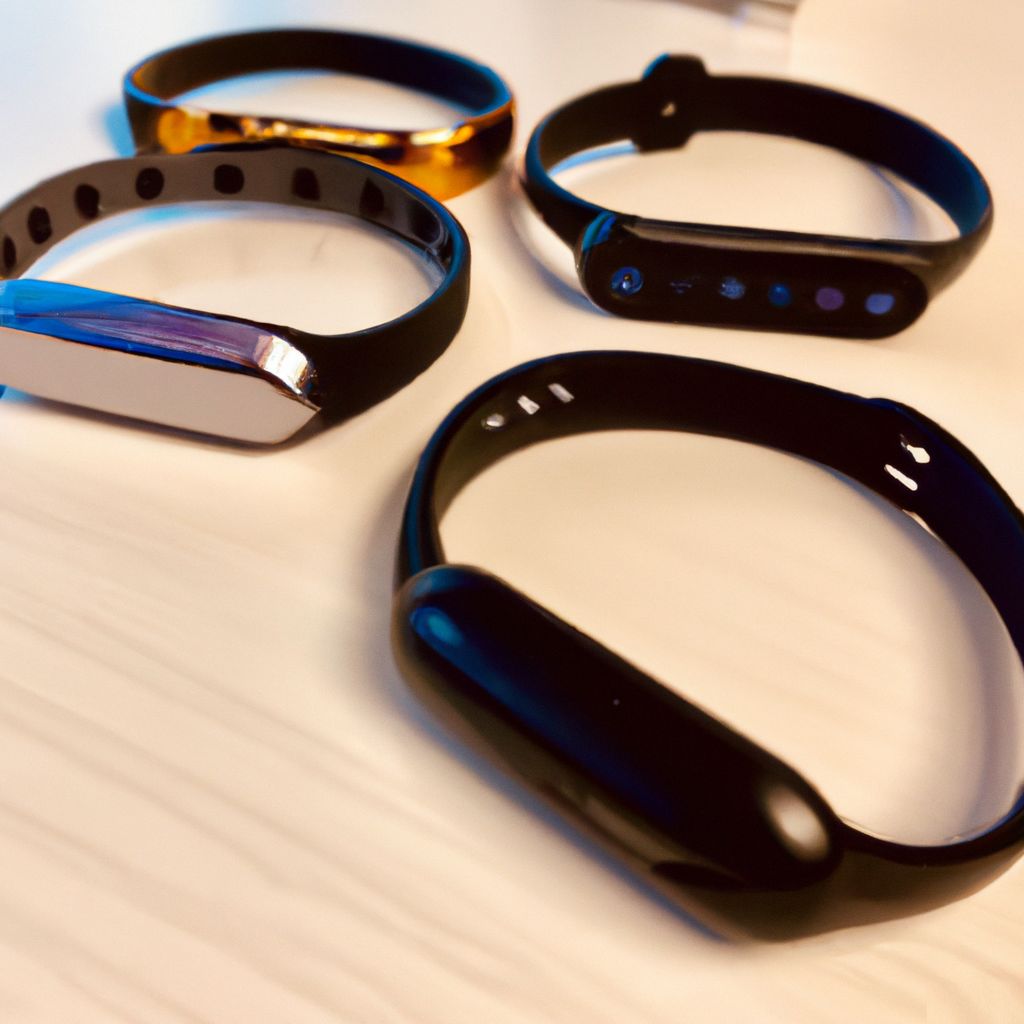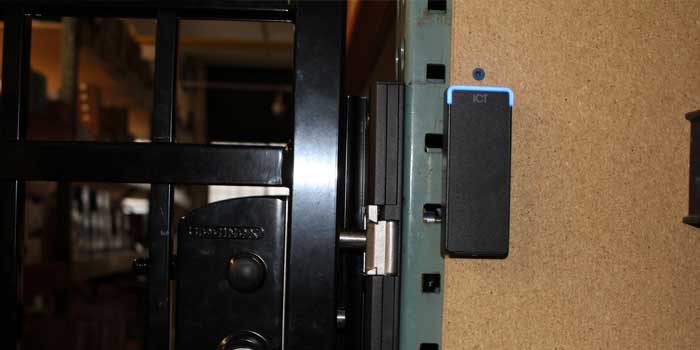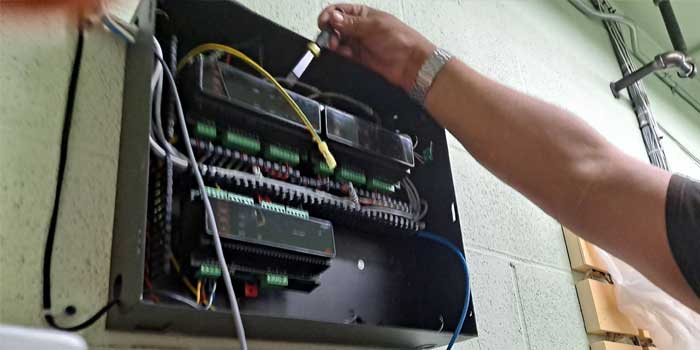Video MGMT System
 Access Control
Access Control
Voice & Data Wiring
 Burglar Alarm
Burglar Alarm
 Fire Alarm
Fire Alarm
Video MGMT System
Voice & Data Wiring
RFID (Radio Frequency Identification) and Bluetooth Low Energy (BLE) are two popular security technologies that have revolutionized access control.
We'll delve into the RFID vs. Bluetooth debate, focusing on access control credentials and comparing the pros and cons of using RFID and Bluetooth signals for ID authentication.
RFID, or Radio Frequency Identification, is a technology that uses radio waves to read and capture information stored on a tag attached to a credential.

Bluetooth is a wireless technology standard used for exchanging data between access control credential readers and mobile devices over short distances.
The best way to draw a line in the sand between RFID and Bluetooth is to compare them head-on.
RFID tags can be read from a greater distance, up to 100 feet, depending on the type of tag and reader. Bluetooth, however, typically has a range of about 30 feet.
RFID readers can operate for a longer time because they consume less power. Bluetooth devices, despite being low energy, have higher power consumption.
Bluetooth technology, capable of transferring data at a speed of 2 to 3 Mbps, takes the cake when it comes to data transfer rates.

RFID technology has long been a staple in access control systems. It uses radio waves to communicate between RFID tags and readers. Access control credentials that often use RFID signals for ID authentication are key cards, proximity cards, and fobs.
The two primary types of RFID technology are active RFID and passive RFID.
Active RFID tags come equipped with an internal power source, typically a battery, allowing for a longer communication range of up to 100 meters. These tags can send data proactively, offering real-time tracking capabilities.
Passive RFID tags, on the other hand, rely on an RFID reader's activation signal to function. The reader's radio waves energize the tag, which then sends data back to the reader.
Passive RFID tags have a shorter communication range (a few centimeters to a few meters) but have lower costs and power consumption.
Bluetooth Low Energy, or BLE, is a wireless technology that enables data transfer between mobile devices and Bluetooth-compatible devices over short distances.
BLE excels in creating smart access control systems by integrating with smartphones and other Bluetooth-enabled devices.

Bluetooth technology can be used in a variety of access control credentials, including smartphones, smart watches, Bluetooth cards, Bluetooth fobs, Bluetooth tags on keys and ID badges, and Bluetooth wearables, like fitness bands or Bluetooth-enabled jewelry.
BLE technology boasts low power consumption, making it ideal for battery-powered devices like Bluetooth beacons and tags.
BLE provides real-time location services and can communicate with multiple devices simultaneously.
When it comes to access control credentials, RFID and Bluetooth both offer unique advantages.
Active RFID systems have a longer communication range compared to passive RFID and BLE systems. This extended range is beneficial for tracking high-value assets or monitoring access to large facilities.
Passive RFID tags and BLE technology both have low power consumption. However, BLE consumes slightly more power than passive RFID tags.
It's essential to consider the overall power requirements of the entire system before choosing between the two.
Passive RFID tags have a lower cost, whereas BLE systems may have a higher overall cost due to the need for Bluetooth-compatible devices and infrastructure.

Asset tracking is an integral part of any access control system. Both RFID and Bluetooth technologies have distinct advantages when it comes to asset tracking.
RFID technology, particularly passive RFID, is a popular choice for asset tracking in supply chains. RFID technology enables multiple tags to be read simultaneously and assets to be tracked over a wide range of distances.
Bluetooth Low Energy technology offers real-time location tracking and proximity detection. This feature is valuable for monitoring the movement of assets within a designated area.
RFID and Bluetooth technologies can coexist and complement each other within access control systems.

Offering both RFID and Bluetooth options can improve user experience by providing more choices. For instance, users can opt for traditional RFID cards or key fobs, or they can use Bluetooth-enabled smartphones for access.
These readers are capable of reading both RFID and Bluetooth credentials, allowing for seamless integration of both technologies.
Depending on your needs, you can use RFID cards, key fobs, Bluetooth-enabled smartphones, or other compatible devices as access credentials.
Use access control software that supports both RFID and Bluetooth technologies. This software should allow for easy management and configuration of access credentials.

Hire security professionals to install and configure your Bluetooth/RFID access control system to ensure optimal performance and security. Professionals can ensure that all system components are working harmoniously and securely.
RFID technology is set to become even more efficient and versatile, with advancements in data storage capacity, read range, and cost-effectiveness.
On the other hand, Bluetooth Low Energy technology will continue to evolve with the growing Internet of Things (IoT) landscape, providing seamless and efficient connectivity for access control systems.

While this article provides a comprehensive comparison of RFID and Bluetooth technologies, choosing the right technology for your specific needs may still seem daunting. That's where the experts come in.
At Mammoth Security, we specialize in designing, installing, and programming comprehensive security systems. Our expertise extends beyond RFID and Bluetooth devices to include comprehensive security solutions for intrusion detection, video surveillance, and access control. Plus, we install low-voltage cabling for security system data and enhanced telecommunications.
So why wait? Take the first step towards enhancing your security by filling out the form below to set up an appointment with one of our Mammoth Security experts. Let us provide robust and efficient security solutions tailored just for you.
NOT COMPLETELY SURE?
860-748-4292Absolutely! An access control system can use both RFID and BLE technology to provide a holistic, efficient, and user-friendly security solution.
RFID systems can be vulnerable to cloning and eavesdropping, while Bluetooth systems can be prone to 'bluejacking' or unauthorized access. Therefore, additional security measures, such as two-step verification, should be implemented to control access to highly sensitive or restricted sites.
Yes, but it requires careful consideration of the compatibility of your current system with Bluetooth technology.
Bluetooth is often considered the more user-friendly technology, especially with younger users, as it can be stored on smartphones.
Active RFID systems have a longer communication range of up to 100 meters, while passive RFID and BLE have a shorter range, typically up to a few meters.
Passive RFID tags are less expensive. However, the cost can vary depending on the complexity of the system and the brand.